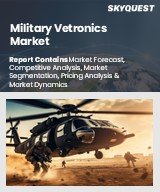
|
시장보고서
상품코드
1800782
베트로닉스 시장 보고서 : 용도, 차종, 서브시스템, 피트, 지역별(2025-2033년)Vetronics Market Report by Application, Vehicle Type, Subsystem, Fit, and Region 2025-2033 |
||||||
세계 베트로닉스 시장 규모는 2024년 33억 달러에 달했습니다. 향후 IMARC Group은 이 시장이 2033년까지 51억 달러에 달할 것으로 예상하며, 2025-2033년 연평균 성장률(CAGR)은 4.59%에 달할 것으로 예측하고 있습니다.
베트로닉스(Vehicle Electronics)는 자동차 내 다양한 전자 서브시스템의 집합체를 말합니다. 주로 군부대가 통신, 지휘, 내비게이션, 감시, 차량 건강 관리 등의 시스템을 통합하는 데 사용됩니다. 자율주행, 센서, 안전한 통신 시스템 등 다양한 자동차 전자기술로 구성되어 있습니다. 이 시스템은 전투전차, 경장갑차, 장갑차, 보병전투차량에 통합되어 있습니다. 또한 HD 영상통화, 고급 위협 감지 센서, 광대역 네트워킹, 휴대용 전원 시스템 등 첨단 기술도 탑재되어 있습니다.
자동차 산업의 괄목할만한 성장은 시장 성장을 촉진하는 주요 요인 중 하나입니다. 또한, 군 및 방위 서비스가 상황 인식 강화에 중점을 두고 있는 것도 시장 성장을 촉진하고 있습니다. 지정학적 불안과 국경을 넘나드는 보안에 대한 우려가 높아지고, 국경 침범 사례가 증가함에 따라 차량 간 및 차량 내 통신, 감시, 내비게이션 개선을 위해 베트로닉스의 도입이 확대되고 있습니다. 또한, 무선 통신 기술의 등장, 군용 차량의 현대화 진행 등 다양한 기술 발전도 시장에 긍정적인 영향을 미치고 있습니다. 예를 들어, 무인자동차(UMV)나 드론은 스포츠 행사나 도시 풍경의 이미지 및 동영상 촬영 등 다양한 상업적 용도와 함께 감시 목적으로 사용되고 있습니다. 그 외 비용 효율적인 부품의 가용성, 국방 분야에 대한 정부 투자 증가 등이 시장을 더욱 견인할 것으로 예상됩니다.
본 보고서에서 다루는 주요 질문
- 베트로닉스 세계 시장은 지금까지 어떻게 성장해왔고, 앞으로 어떻게 성장할 것인가?
- 주요 지역 시장은?
- COVID-19가 세계 베테로닉스 시장에 미치는 영향은?
- 용도별 시장 내역은?
- 차종별 시장 현황은?
- 서브시스템별 시장 현황은?
- 적합도별 시장 분석은?
- 산업 가치사슬의 다양한 단계는 무엇인가?
- 업계의 주요 촉진요인과 과제는 무엇인가?
- 세계 베트로닉스 시장 구조와 주요 기업은?
- 업계 내 경쟁은 어느 정도인가?
목차
제1장 서문
제2장 조사 범위와 조사 방법
- 조사 목적
- 이해관계자
- 데이터 소스
- 1차 정보
- 2차 정보
- 시장 추정
- 상향식 접근
- 하향식 접근
- 조사 방법
제3장 주요 요약
제4장 소개
제5장 세계의 베트로닉스 시장
- 시장 개요
- 시장 실적
- COVID-19의 영향
- 시장 예측
제6장 시장 내역 : 용도별
- 방위
- 국토안보부
제7장 시장 내역 : 차종별
- 주력전차
- 경방호차량
- 수륙양용장갑차
- 지뢰 내성·매복 방호(MRAP) 차량
- 보병전투차
- 병력수송장갑차
- 기타
제8장 시장 내역 : 서브시스템별
- 내비게이션 시스템
- 관찰 및 표시 시스템
- C3 시스템
- 무기 제어 시스템
- 센서 및 제어 시스템
- 차량 보호 시스템
- 전력 시스템
- 기타
제9장 시장 내역 : 피트별
- 라인피트
- 개조
제10장 시장 내역 : 지역별
- 북미
- 미국
- 캐나다
- 아시아태평양
- 중국
- 일본
- 인도
- 한국
- 호주
- 인도네시아
- 기타
- 유럽
- 독일
- 프랑스
- 영국
- 이탈리아
- 스페인
- 러시아
- 기타
- 라틴아메리카
- 브라질
- 멕시코
- 기타
- 중동 및 아프리카
제11장 SWOT 분석
제12장 밸류체인 분석
제13장 가격 지표
제14장 Porter's Five Forces 분석
제15장 경쟁 구도
- 시장 구조
- 주요 기업
- 주요 기업 개요
- BAE Systems PLC
- Curtiss-Wright Corporation
- General Dynamics Corporation
- Harris Corporation
- Leonardo-Finmeccanica S.P.A
- Lockheed Martin Corporation
- Raytheon Company
- Rheinmetall AG
- Saab Group
- Thales Group
The global vetronics market size reached USD 3.3 Billion in 2024. Looking forward, IMARC Group expects the market to reach USD 5.1 Billion by 2033, exhibiting a growth rate (CAGR) of 4.59% during 2025-2033.
Vetronics, or vehicle electronics, refers to the collection of various electronic subsystems within an automobile. It is primarily used by military units to integrate systems, such as communication, command, navigation, surveillance and vehicle health management. It consists of various automotive electronic technologies, such as autonomous driving, sensors and secure communications systems. These systems are integrated with battle tanks, and light-protected, armored and infantry fighting vehicles. They are also equipped with sophisticated technologies, such as HD video calling, advanced threat detection sensors, high bandwidth networking and portable power systems.
Significant growth in the automotive industry is one of the key factors driving the growth of the market. Furthermore, the increasing focus of military and defense services on enhancing their situational awareness is also providing a boost to the market growth. Owing to the rising concerns regarding geopolitical unrest and cross-border security, along with increasing instances of border breaching, there is widespread adoption of vetronics for improving inter- and intra-vehicle communications, surveillance and navigation. Additionally, various technological advancements, including the emergence of wireless communications technology and increasing modernization of military vehicles, are also creating a positive impact on the market. For instance, unmanned vehicles (UMV) and drones are used for surveillance purposes, along with various commercial applications, such as capturing images and videos of sporting events and cityscapes. Other factors, including the availability of cost-effective components and increasing government investments in the defense sector, are projected to drive the market further.
Key Market Segmentation:
Breakup by Application:
- Defense
- Homeland Security
Breakup by Vehicle Type:
- Main Battle Tanks
- Light Protected Vehicles
- Amphibious Armoured Vehicles
- Mine Resistant Ambush Protected (MRAP) Vehicles
- Infantry Fighting Vehicles
- Armored Personnel Carriers
- Others
Breakup by Subsystem:
- Navigation Systems
- Observation and Display Systems
- C3 Systems
- Weapon Control Systems
- Sensor and Control Systems
- Vehicle Protection Systems
- Power Systems
- Others
Breakup by Fit:
- Line-Fit
- Retrofit
Breakup by Region:
- North America
- United States
- Canada
- Asia Pacific
- China
- Japan
- India
- South Korea
- Australia
- Indonesia
- Others
- Europe
- Germany
- France
- United Kingdom
- Italy
- Spain
- Russia
- Others
- Latin America
- Brazil
- Mexico
- Others
- Middle East and Africa
Competitive Landscape:
The competitive landscape of the industry has also been examined with some of the key players being BAE Systems PLC, Curtiss-Wright Corporation, General Dynamics Corporation, Harris Corporation, Leonardo-Finmeccanica S.P.A, Lockheed Martin Corporation, Raytheon Company, Rheinmetall AG, Saab Group, Thales Group, etc.
Key Questions Answered in This Report:
- How has the global vetronics market performed so far and how will it perform in the coming years?
- What are the key regional markets?
- What has been the impact of COVID-19 on the global vetronics market?
- What is the breakup of the market based on the application?
- What is the breakup of the market based on the vehicle type?
- What is the breakup of the market based on the subsystem?
- What is the breakup of the market based on the fit?
- What are the various stages in the value chain of the industry?
- What are the key driving factors and challenges in the industry?
- What is the structure of the global vetronics market and who are the key players?
- What is the degree of competition in the industry?
Table of Contents
1 Preface
2 Scope and Methodology
- 2.1 Objectives of the Study
- 2.2 Stakeholders
- 2.3 Data Sources
- 2.3.1 Primary Sources
- 2.3.2 Secondary Sources
- 2.4 Market Estimation
- 2.4.1 Bottom-Up Approach
- 2.4.2 Top-Down Approach
- 2.5 Forecasting Methodology
3 Executive Summary
4 Introduction
- 4.1 Overview
- 4.2 Key Industry Trends
5 Global Vetronics Market
- 5.1 Market Overview
- 5.2 Market Performance
- 5.3 Impact of COVID-19
- 5.4 Market Forecast
6 Market Breakup by Application
- 6.1 Defense
- 6.1.1 Market Trends
- 6.1.2 Market Forecast
- 6.2 Homeland Security
- 6.2.1 Market Trends
- 6.2.2 Market Forecast
7 Market Breakup by Vehicle Type
- 7.1 Main Battle Tanks
- 7.1.1 Market Trends
- 7.1.2 Market Forecast
- 7.2 Light Protected Vehicles
- 7.2.1 Market Trends
- 7.2.2 Market Forecast
- 7.3 Amphibious Armoured Vehicles
- 7.3.1 Market Trends
- 7.3.2 Market Forecast
- 7.4 Mine Resistant Ambush Protected (MRAP) Vehicles
- 7.4.1 Market Trends
- 7.4.2 Market Forecast
- 7.5 Infantry Fighting Vehicles
- 7.5.1 Market Trends
- 7.5.2 Market Forecast
- 7.6 Armored Personnel Carriers
- 7.6.1 Market Trends
- 7.6.2 Market Forecast
- 7.7 Others
- 7.7.1 Market Trends
- 7.7.2 Market Forecast
8 Market Breakup by Subsystem
- 8.1 Navigation Systems
- 8.1.1 Market Trends
- 8.1.2 Market Forecast
- 8.2 Observation and Display Systems
- 8.2.1 Market Trends
- 8.2.2 Market Forecast
- 8.3 C3 Systems
- 8.3.1 Market Trends
- 8.3.2 Market Forecast
- 8.4 Weapon Control Systems
- 8.4.1 Market Trends
- 8.4.2 Market Forecast
- 8.5 Sensor and Control Systems
- 8.5.1 Market Trends
- 8.5.2 Market Forecast
- 8.6 Vehicle Protection Systems
- 8.6.1 Market Trends
- 8.6.2 Market Forecast
- 8.7 Power Systems
- 8.7.1 Market Trends
- 8.7.2 Market Forecast
- 8.8 Others
- 8.8.1 Market Trends
- 8.8.2 Market Forecast
9 Market Breakup by Fit
- 9.1 Line-Fit
- 9.1.1 Market Trends
- 9.1.2 Market Forecast
- 9.2 Retrofit
- 9.2.1 Market Trends
- 9.2.2 Market Forecast
10 Market Breakup by Region
- 10.1 North America
- 10.1.1 United States
- 10.1.1.1 Market Trends
- 10.1.1.2 Market Forecast
- 10.1.2 Canada
- 10.1.2.1 Market Trends
- 10.1.2.2 Market Forecast
- 10.1.1 United States
- 10.2 Asia Pacific
- 10.2.1 China
- 10.2.1.1 Market Trends
- 10.2.1.2 Market Forecast
- 10.2.2 Japan
- 10.2.2.1 Market Trends
- 10.2.2.2 Market Forecast
- 10.2.3 India
- 10.2.3.1 Market Trends
- 10.2.3.2 Market Forecast
- 10.2.4 South Korea
- 10.2.4.1 Market Trends
- 10.2.4.2 Market Forecast
- 10.2.5 Australia
- 10.2.5.1 Market Trends
- 10.2.5.2 Market Forecast
- 10.2.6 Indonesia
- 10.2.6.1 Market Trends
- 10.2.6.2 Market Forecast
- 10.2.7 Others
- 10.2.7.1 Market Trends
- 10.2.7.2 Market Forecast
- 10.2.1 China
- 10.3 Europe
- 10.3.1 Germany
- 10.3.1.1 Market Trends
- 10.3.1.2 Market Forecast
- 10.3.2 France
- 10.3.2.1 Market Trends
- 10.3.2.2 Market Forecast
- 10.3.3 United Kingdom
- 10.3.3.1 Market Trends
- 10.3.3.2 Market Forecast
- 10.3.4 Italy
- 10.3.4.1 Market Trends
- 10.3.4.2 Market Forecast
- 10.3.5 Spain
- 10.3.5.1 Market Trends
- 10.3.5.2 Market Forecast
- 10.3.6 Russia
- 10.3.6.1 Market Trends
- 10.3.6.2 Market Forecast
- 10.3.7 Others
- 10.3.7.1 Market Trends
- 10.3.7.2 Market Forecast
- 10.3.1 Germany
- 10.4 Latin America
- 10.4.1 Brazil
- 10.4.1.1 Market Trends
- 10.4.1.2 Market Forecast
- 10.4.2 Mexico
- 10.4.2.1 Market Trends
- 10.4.2.2 Market Forecast
- 10.4.3 Others
- 10.4.3.1 Market Trends
- 10.4.3.2 Market Forecast
- 10.4.1 Brazil
- 10.5 Middle East and Africa
- 10.5.1 Market Trends
- 10.5.2 Market Breakup by Country
- 10.5.3 Market Forecast
11 SWOT Analysis
- 11.1 Overview
- 11.2 Strengths
- 11.3 Weaknesses
- 11.4 Opportunities
- 11.5 Threats
12 Value Chain Analysis
13 Price Indicators
14 Porters Five Forces Analysis
- 14.1 Overview
- 14.2 Bargaining Power of Buyers
- 14.3 Bargaining Power of Suppliers
- 14.4 Degree of Competition
- 14.5 Threat of New Entrants
- 14.6 Threat of Substitutes
15 Competitive Landscape
- 15.1 Market Structure
- 15.2 Key Players
- 15.3 Profiles of Key Players
- 15.3.1 BAE Systems PLC
- 15.3.1.1 Company Overview
- 15.3.1.2 Product Portfolio
- 15.3.1.3 Financials
- 15.3.1.4 SWOT Analysis
- 15.3.2 Curtiss-Wright Corporation
- 15.3.2.1 Company Overview
- 15.3.2.2 Product Portfolio
- 15.3.2.3 Financials
- 15.3.2.4 SWOT Analysis
- 15.3.3 General Dynamics Corporation
- 15.3.3.1 Company Overview
- 15.3.3.2 Product Portfolio
- 15.3.3.3 Financials
- 15.3.3.4 SWOT Analysis
- 15.3.4 Harris Corporation
- 15.3.4.1 Company Overview
- 15.3.4.2 Product Portfolio
- 15.3.5 Leonardo-Finmeccanica S.P.A
- 15.3.5.1 Company Overview
- 15.3.5.2 Product Portfolio
- 15.3.5.3 Financials
- 15.3.5.4 SWOT Analysis
- 15.3.6 Lockheed Martin Corporation
- 15.3.6.1 Company Overview
- 15.3.6.2 Product Portfolio
- 15.3.6.3 Financials
- 15.3.6.4 SWOT Analysis
- 15.3.7 Raytheon Company
- 15.3.7.1 Company Overview
- 15.3.7.2 Product Portfolio
- 15.3.7.3 Financials
- 15.3.7.4 SWOT Analysis
- 15.3.8 Rheinmetall AG
- 15.3.8.1 Company Overview
- 15.3.8.2 Product Portfolio
- 15.3.9 Saab Group
- 15.3.9.1 Company Overview
- 15.3.9.2 Product Portfolio
- 15.3.10 Thales Group
- 15.3.10.1 Company Overview
- 15.3.10.2 Product Portfolio
- 15.3.10.3 Financials
- 15.3.1 BAE Systems PLC













